Assessment of Personal Occupational Exposure to Radiofrequency Electromagnetic Fields in Libraries and Media Libraries, Using Calibrated On-Body Exposimeters
Abstract
1. Introduction
2. Methodology
2.1. Site Characterization
2.2. Employee Selection
2.3. Measurement Strategy and Equipment
2.3.1. Measurement Strategies
- rapid analysis of the whole site, to identify relevant areas: Spatial scanning, and configuration analysis of sources, work-stations, and places where personnel tend to stay;
- adaptation of measurement procedures according to frequency bands and equipment used.
2.3.2. Materials
2.3.3. Measurement Implementation
2.4. Data Analysis
2.5. Ethics, Consent, and Health-and-Safety Submission
3. Results
3.1. Individual Samples
3.2. Static Pathway Measurements
4. Discussion
Study Strengths and Weaknesses
5. Conclusions
What is New in This Paper?
Author Contributions
Funding
Acknowledgments
Conflicts of Interest
References
- Baan, R.; Grosse, Y.; Lauby-Secretan, B.; El Ghissassi, F.; Bouvard, V.; Benbrahim-Tallaa, L.; Guha, N.; Islami, F.; Galichet, L.; Straif, K. WHO International Agency for Research on Cancer Monograph Working Group. Carcinogenicity of radiofrequency electromagnetic fields. Lancet Oncol. 2011, 12, 624–626. [Google Scholar] [CrossRef]
- Sagar, S.; Dongus, S.; Schoeni, A.; Roser, K.; Eeftens, M.; Struchen, B.; Foerster, M.; Meier, N.; Adem, S.; Roosli, M. Radiofrequency electromagnetic field exposure in everyday microenvironments in Europe: A systematic literature review. J. Expo. Sci. Environ. Epidemiol. 2018, 28, 147–160. [Google Scholar] [CrossRef] [PubMed]
- Urbinello, D.; Joseph, W.; Verloock, L.; Martens, L.; Roosli, M. Temporal trends of radio-frequency electromagnetic field (RF-EMF) exposure in everyday environments across European cities. Environ. Res. 2014, 134, 134–142. [Google Scholar] [CrossRef] [PubMed]
- Sagar, S.; Adem, S.M.; Struchen, B.; Loughran, S.P.; Brunjes, M.E.; Arangua, L.; Dalvie, M.A.; Croft, R.J.; Jerrett, M.; Moskowitz, J.M.; et al. Comparison of radiofrequency electromagnetic field exposure levels in different everyday microenvironments in an international context. Environ. Int. 2018, 114, 297–306. [Google Scholar] [CrossRef] [PubMed]
- Osei, S.; Amoako, J.K.; Fletcher, J.J. Assessment of levels of occupational exposure to workers in radiofrequency fields of two television stations in Accra, Ghana. Radiat. Prot. Dosimetry 2016, 168, 419–426. [Google Scholar] [CrossRef]
- Hareuveny, R.; Kavet, R.; Shachar, A.; Margaliot, M.; Kheifets, L. Occupational exposures to radiofrequency fields: Results of an Israeli national survey. J. Radiol. Prot. 2015, 35, 429–445. [Google Scholar] [CrossRef]
- Bolte, J.F. Lessons learnt on biases and uncertainties in personal exposure measurement surveys of radiofrequency electromagnetic fields with exposimeters. Environ. Int. 2016, 94, 724–735. [Google Scholar] [CrossRef]
- Litchfield, I.; van Tongeren, M.; Sorahan, T. Radiofrequency Exposure amongst Employees of Mobile Network Operators and Broadcasters. Radiat. Prot. Dosimetry 2017, 175, 178–185. [Google Scholar] [CrossRef]
- ICNIRP (International Commission on Non-Ionizing Radiation Protection). Guidelines for Limiting Exposure to Time-Varying Electric, Magnetic, and Electromagnetic Fields (up to 300 GHz). Health Phys. 1998, 74, 494–522. [Google Scholar]
- ICNIRP. Guidelines for limiting exposure to time-varying electric and magnetic fields (1 Hz to 100 kHz). Health Phys. 2010, 99, 818–836. [Google Scholar]
- Karipidis, K.; Henderson, S.; Wijayasinghe, D.; Tjong, L.; Tinker, R. Exposure to Radiofrequency Electromagnetic Fields from Wi-Fi in Australian Schools. Radiat. Prot. Dosimetry 2017, 175, 432–439. [Google Scholar] [CrossRef] [PubMed]
- Van Wel, L.; Vermeulen, R.; van Eijsden, M.; Vrijkotte, T.; Kromhout, H.; Huss, A. Radiofrequency exposure levels in Amsterdam schools. Bioelectromagnetics 2017, 38, 397–400. [Google Scholar] [CrossRef] [PubMed]
- Bolte, J.F.; Eikelboom, T. Personal radiofrequency electromagnetic field measurements in The Netherlands: Exposure level and variability for everyday activities, times of day and types of area. Environ. Int. 2012, 48, 133–142. [Google Scholar] [CrossRef] [PubMed]
- Viel, J.-F.; Cardis, E.; Moissonnier, M.; de Seze, R.; Hours, M. Radiofrequency exposure in the French general population: Band, time, location and activity variability. Environ. Int. 2009, 35, 1150–1154. [Google Scholar] [CrossRef] [PubMed]
- Chiaramello, E.; Bonato, M.; Fiocchi, S.; Tognola, G.; Parazzini, M.; Ravazzani, P.; Wiart, J. Radio Frequency Electromagnetic Fields Exposure Assessment in Indoor Environments: A Review. Int. J. Environ. Res. Public Health 2019, 16, 955. [Google Scholar] [CrossRef] [PubMed]
- Dunbar, S.W.; Goldberg, D.J. Radiofrequency in Cosmetic Dermatology: An Update. J. Drugs Dermatol. 2015, 14, 1229–1238. [Google Scholar]
- Cooper, T.G.; Allen, S.G.; Blackwell, R.P.; Litchfield, I.; Mann, S.M.; Pope, J.M.; van Tongeren, M.J. Assessment of occupational exposure to radiofrequency fields and radiation. Radiat. Prot. Dosimetry 2004, 111, 191–203. [Google Scholar] [CrossRef]
- Alanko, T.; Hietanen, M. Occupational exposure to radiofrequency fields in antenna towers. Radiat. Prot. Dosimetry 2007, 123, 537–539. [Google Scholar] [CrossRef]
- Vila, J.; Bowman, J.D.; Kincl, L.; Conover, D.L.; van Tongeren, M.; Figuerola, J.; Richardson, L.; Cardis, E. Development of a source-based approach to assessing occupational exposure to electromagnetic fields in the INTEROCC. Occup. Environ. Med. 2014, 71, 35–36. [Google Scholar] [CrossRef][Green Version]
- Vila, J.; Bowman, J.D.; Richardson, L.; Kincl, L.; Conover, D.L.; McLean, D.; Mann, S.; Vecchia, P.; van Tongeren, M.; Cardis, E. A Source-based Measurement Database for Occupational Exposure Assessment of Electromagnetic Fields in the INTEROCC Study: A Literature Review Approach. Ann. Occup. Hyg. 2016, 60, 184–204. [Google Scholar] [CrossRef]
- Blas, J.; Lago, F.A.; Fernandez, P.; Lorenzo, R.M.; Abril, E.J. Potential exposure assessment errors associated with body-worn RF dosimeters. Bioelectromagnetics 2007, 28, 573–576. [Google Scholar] [CrossRef] [PubMed]
- Durrenberger, G.; Frohlich, J.; Roosli, M.; Mattsson, M.O. EMF Monitoring-Concepts, Activities, Gaps and Options. Int. J. Environ. Res. Public Health 2014, 11, 9460–9479. [Google Scholar] [CrossRef] [PubMed]
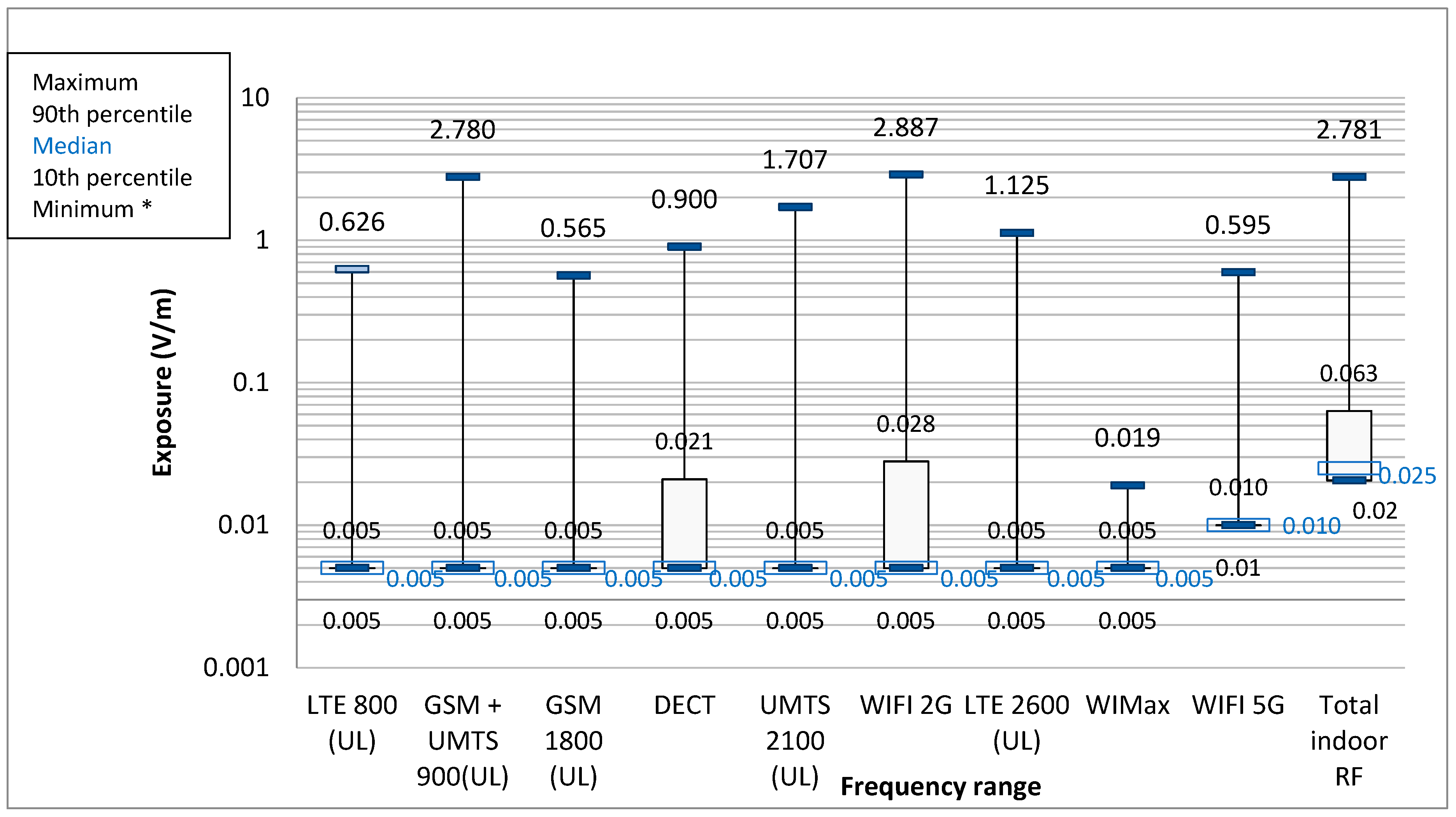
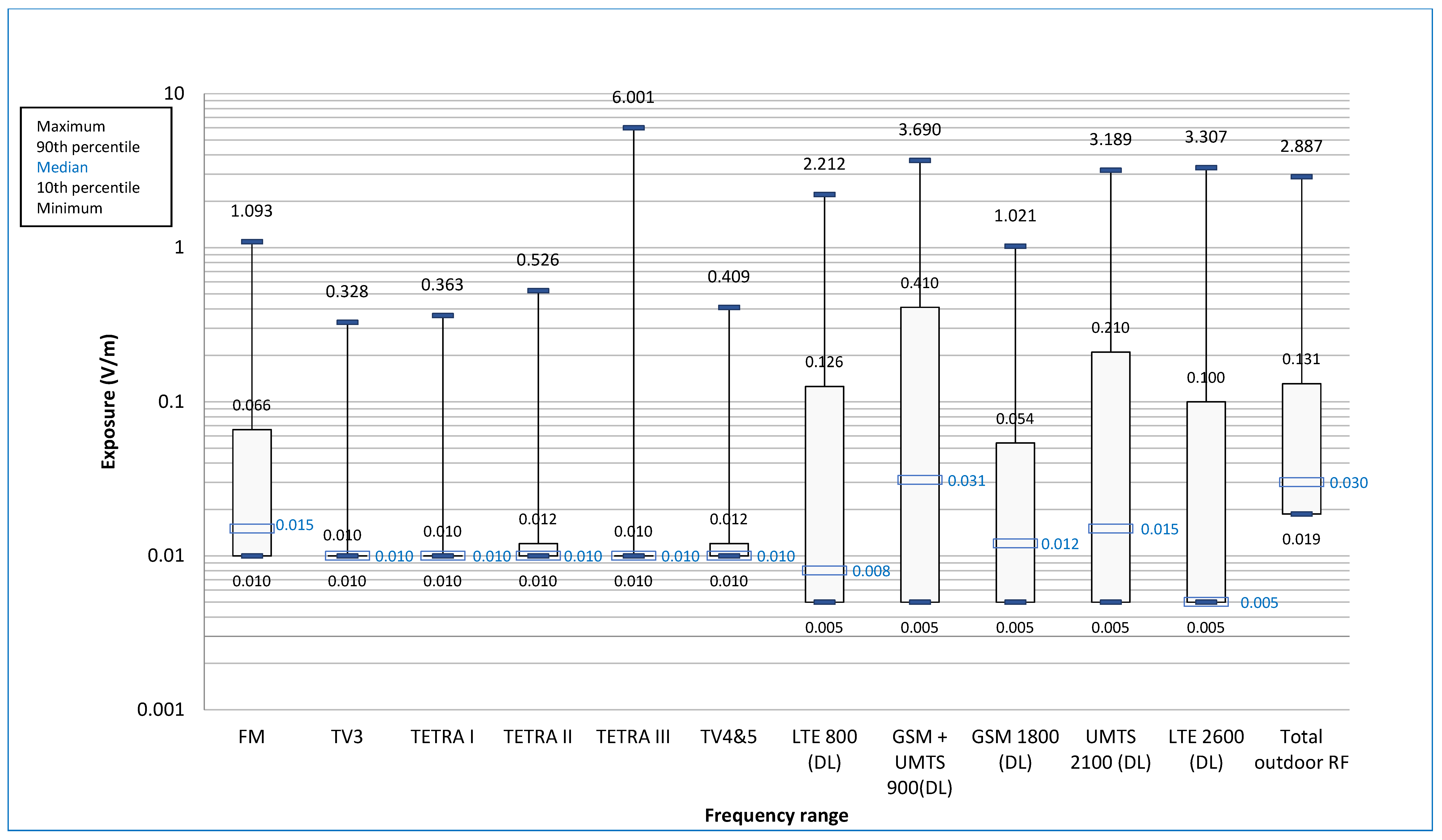
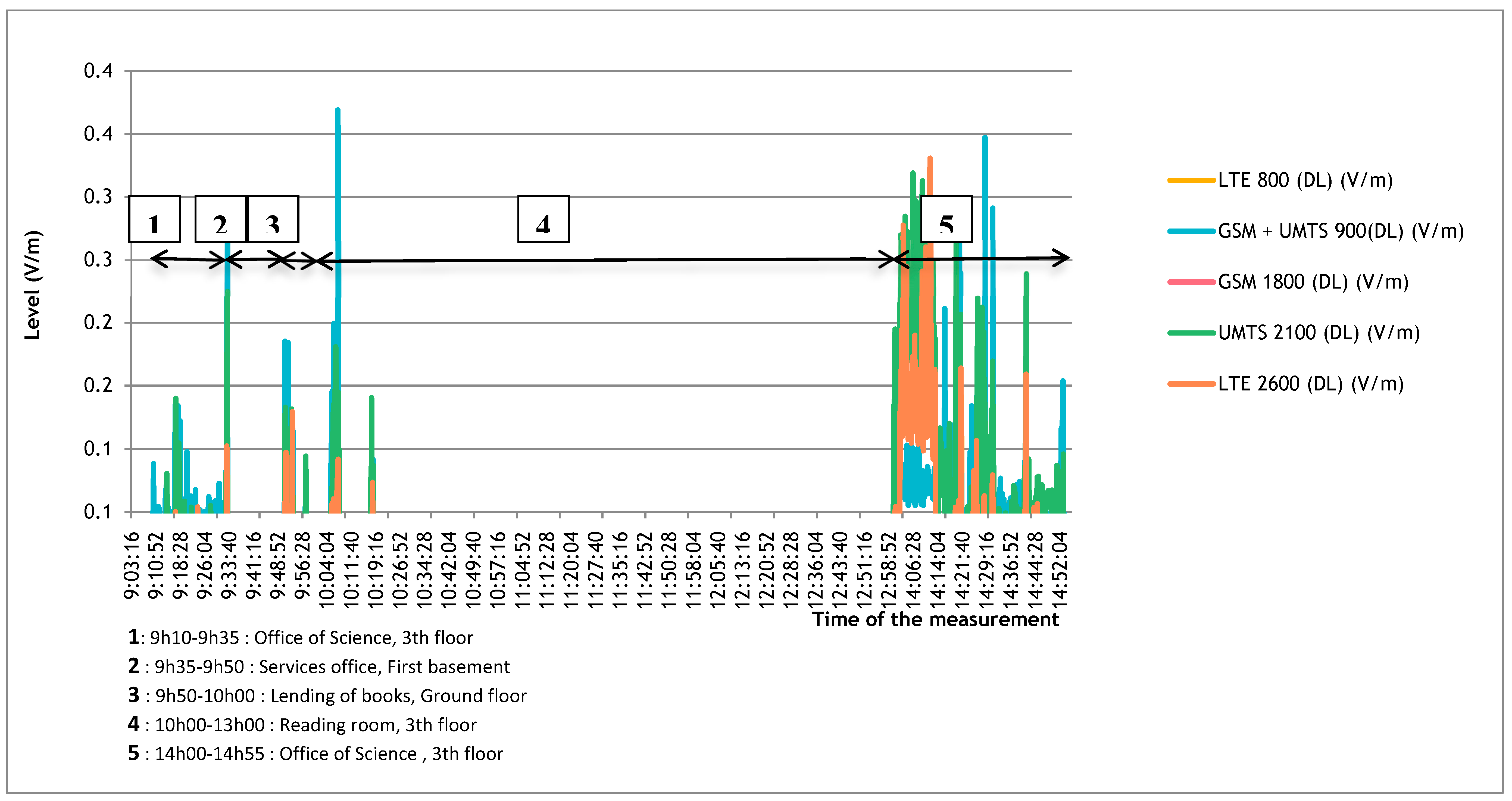
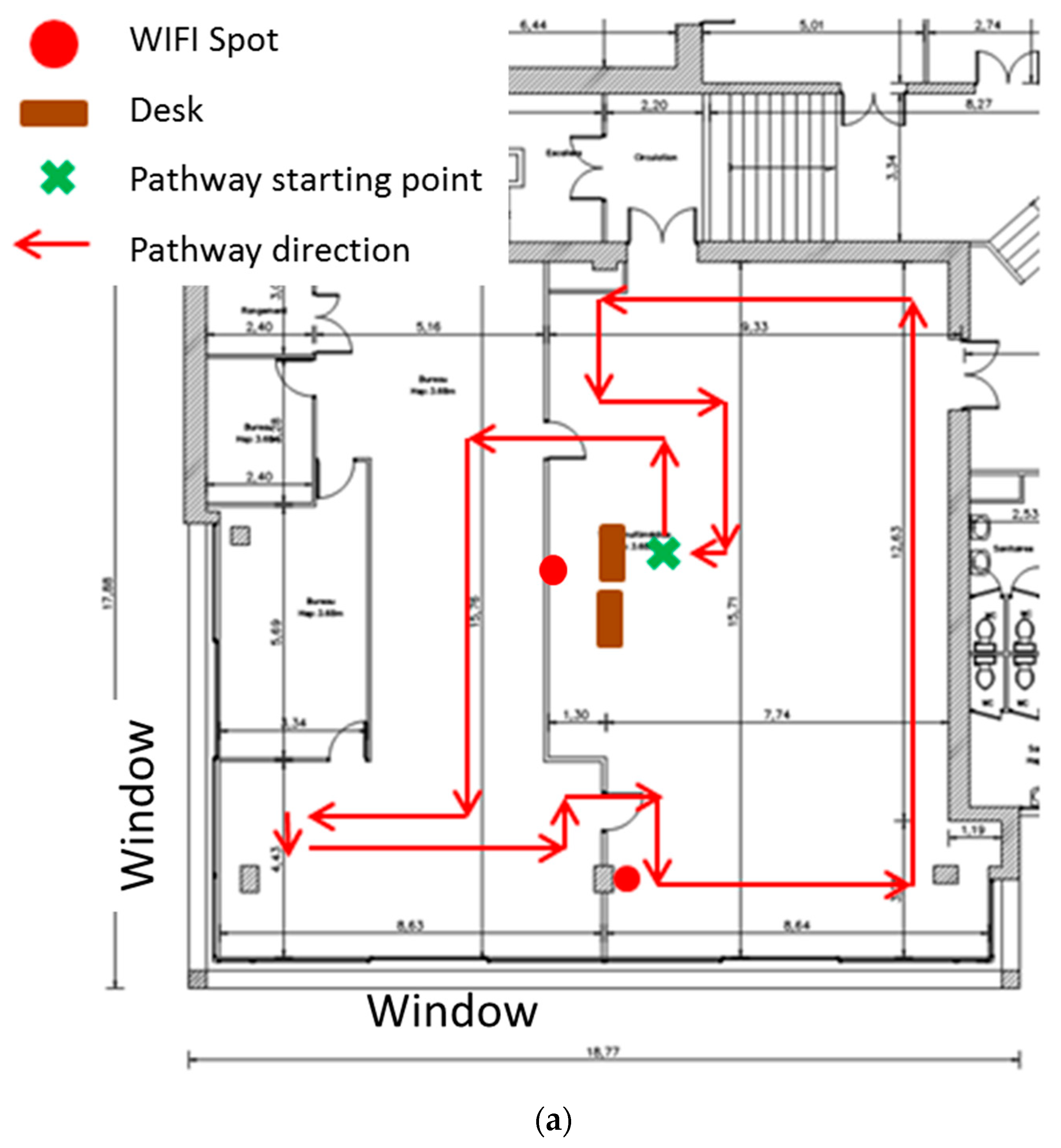
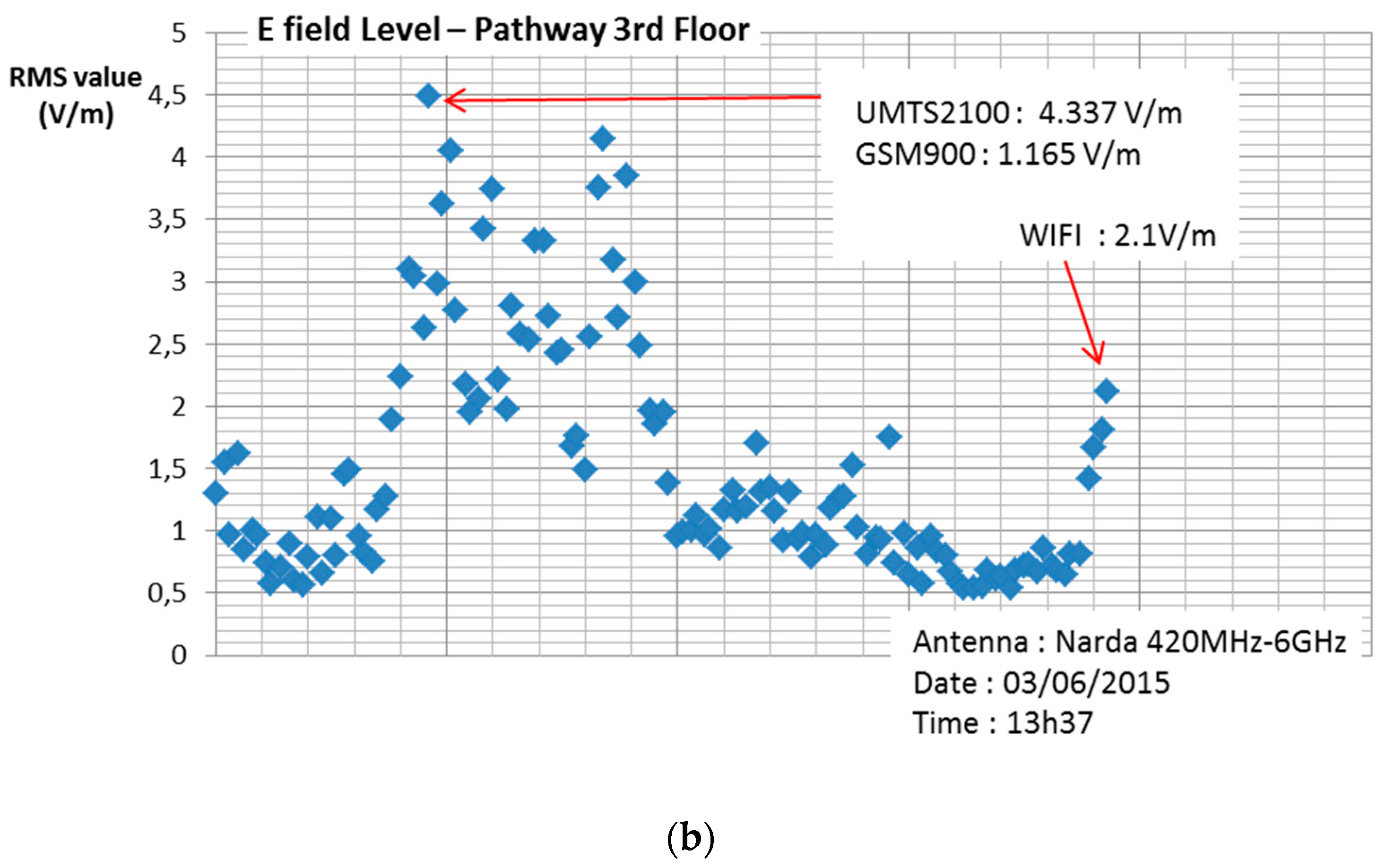
| Frequency Ranges | Frequency Min (MHz) | Frequency Max (MHz) |
|---|---|---|
| Broadcast network FM | 87 | 107 |
| Broadcast network TV3 | 174 | 223 |
| Cellular network TETRA I | 380 | 400 |
| Cellular network TETRA II | 410 | 430 |
| Cellular network TETRA III | 450 | 470 |
| Broadcast network TV 4 & 5 | 470 | 770 |
| Cellular network LTE 800 (DL 1) | 791 | 821 |
| Cellular network LTE 800 (UL 2) | 832 | 862 |
| Cellular network GSM + UMTS 900 (UL 2) | 880 | 915 |
| Cellular network GSM + UMTS 900 (DL 1) | 925 | 960 |
| Cellular network GSM 1800 (UL 2) | 1710 | 1785 |
| Cellular network GSM 1800 (DL 1) | 1805 | 1880 |
| DECT (Cordless phones) | 1880 | 1900 |
| Cellular network UMTS 2100 (UL 2) | 1920 | 1980 |
| Cellular network UMTS 2100 (DL 1) | 2110 | 2170 |
| Wifi 2G | 2400 | 2483.5 |
| Cellular network LTE 2600 [UL 2) | 2500 | 2570 |
| Cellular network LTE 2600 (DL 1) | 2620 | 2690 |
| WIMax | 3300 | 3900 |
| Wifi 5G | 5150 | 5850 |
| Frequency | Mean (V/m) | Standard Deviation (V/m) | Percentage of Samples > Detection Threshold in V/m | Percentage of Samples > 0.5 V/m | Number of Samples > 5 V/m |
|---|---|---|---|---|---|
| FM a | 0.031 | 0.045 | 61.69% | 0.04% | 0 |
| TV3 a | 0.010 | 0.003 | 5.02% | 0.00% | 0 |
| TETRA I a | 0.010 | 0.003 | 2.31% | 0.00% | 0 |
| TETRA II a | 0.011 | 0.006 | 11.37% | 0.00% | 0 |
| TETRA III a | 0.012 | 0.098 | 0.82% | 0.06% | 16 |
| TV4&5 a | 0.012 | 0.008 | 11.71% | 0.00% | 0 |
| LTE 800 (DL) b | 0.042 | 0.076 | 60.11% | 0.41% | 0 |
| LTE 800 (UL) b | 0.005 | 0.004 | 1.12% | 0.00% | 0 |
| GSM + UMTS 900 (UL) b | 0.007 | 0.034 | 4.58% | 0.07% | 0 |
| GSM + UMTS 900 (DL) b | 0.122 | 0.202 | 89.80% | 6.61% | 0 |
| GSM 1800 (UL) b | 0.006 | 0.005 | 9.68% | 0.00% | 0 |
| GSM 1800 (DL) b | 0.025 | 0.039 | 78.05% | 0.06% | 0 |
| DECT b | 0.010 | 0.011 | 39.70% | 0.00% | 0 |
| UMTS 2100 (UL) b | 0.006 | 0.012 | 6.43% | 0.01% | 0 |
| UMTS 2100 (DL) b | 0.072 | 0.140 | 73.23% | 1.48% | 0 |
| WIFI 2G b | 0.011 | 0.024 | 34.06% | 0.02% | 0 |
| LTE 2600 (UL) b | 0.006 | 0.009 | 3.15% | 0.01% | 0 |
| LTE 2600 (DL) b | 0.035 | 0.080 | 49.06% | 0.32% | 0 |
| WIMax b | 0.005 | 0.000 | 0.19% | 0.00% | 0 |
| WIFI 5G a | 0.010 | 0.006 | 3.37% | 0.00% | 0 |
| Total | 0.190 | 0.278 | 99.08% | 11.31% | 16 |
| Site | Number of Measurements | GSM + UMTS 900 (UL) | GSM + UMTS 900 (DL) | Wifi 2G a | CHAMP TOTAL b | |||||||||||||
|---|---|---|---|---|---|---|---|---|---|---|---|---|---|---|---|---|---|---|
| Mean | Standard Deviation | Maximum | Percentage of Measurements >0.005 V/m | Mean | Standard Deviation | Maximum | Percentage of Measurements >0.005 V/m | Mean | Standard Deviation | Maximum | Percentage of Measurements >0.005 V/m | Mean | Standard Deviation | Maximum | Percentage of Measurements >0.005 V/m | |||
| 1 | A | 3628 | 0.01 | 0.01 | 0.23 | 2.40% | 0.04 | 0.04 | 0.87 | 98.93% | 0.008 | 0.008 | 0.092 | 30.13% | 0.15 | 0.10 | 1.06 | 99.83% |
| 2 | A | 2954 | 0.01 | 0.03 | 1.69 | 1.32% | 0.04 | 0.03 | 0.40 | 99.83% | 0.006 | 0.004 | 0.069 | 12.29% | 0.12 | 0.11 | 1.74 | 99.93% |
| 3 | A | 3199 | 0.01 | 0.09 | 2.67 | 11.88% | 0.30 | 0.19 | 1.17 | 99.94% | 0.005 | 0.002 | 0.056 | 1.81% | 0.47 | 0.23 | 2.75 | 100.00% |
| 4 | B | 2897 | 0.03 | 0.12 | 2.78 | 18.64% | 0.01 | 0.00 | 0.05 | 21.88% | 0.007 | 0.006 | 0.118 | 25.16% | 0.04 | 0.12 | 2.78 | 95.65% |
| 5 | B | 3293 | 0.02 | 0.05 | 1.16 | 20.07% | 0.01 | 0.00 | 0.04 | 60.83% | 0.007 | 0.007 | 0.135 | 41.66% | 0.04 | 0.05 | 1.17 | 99.70% |
| 6 | C | 2983 | 0.01 | 0.00 | 0.11 | 0.57% | 0.03 | 0.02 | 0.18 | 99.70% | 0.009 | 0.080 | 2.887 | 14.62% | 0.06 | 0.09 | 2.89 | 99.90% |
| 7 | C | 2749 | 0.01 | 0.00 | 0.07 | 0.87% | 0.01 | 0.01 | 0.07 | 92.32% | 0.006 | 0.002 | 0.055 | 27.21% | 0.04 | 0.03 | 0.78 | 99.96% |
| 8 | D | 2940 | 0.01 | 0.00 | 0.11 | 0.68% | 0.01 | 0.02 | 0.33 | 80.85% | 0.005 | 0.004 | 0.156 | 6.33% | 0.13 | 0.08 | 1.12 | 100.00% |
| 9 | D | 2541 | 0.01 | 0.00 | 0.21 | 0.55% | 0.01 | 0.01 | 0.05 | 27.98% | 0.005 | 0.001 | 0.035 | 1.42% | 0.05 | 0.03 | 0.22 | 100.00% |
| 10 | E | 3136 | 0.01 | 0.00 | 0.09 | 5.01% | 0.08 | 0.08 | 0.63 | 100.00% | 0.012 | 0.027 | 0.627 | 45.41% | 0.14 | 0.17 | 1.33 | 100.00% |
| 11 | E | 2586 | 0.01 | 0.00 | 0.08 | 8.51% | 0.06 | 0.05 | 0.51 | 99.96% | 0.012 | 0.010 | 0.116 | 58.97% | 0.10 | 0.11 | 1.46 | 99.96% |
| 12 | F | 1875 | 0.01 | 0.01 | 0.25 | 0.69% | 0.01 | 0.00 | 0.02 | 80.59% | 0.040 | 0.054 | 0.733 | 92.21% | 0.05 | 0.06 | 0.73 | 97.49% |
| 13 | F | 3561 | 0.01 | 0.02 | 0.80 | 10.50% | 0.02 | 0.01 | 0.03 | 99.72% | 0.042 | 0.013 | 0.248 | 99.97% | 0.05 | 0.03 | 0.80 | 100.00% |
| 14 | C | 2987 | 0.01 | 0.00 | 0.08 | 1.41% | 0.01 | 0.01 | 0.07 | 99.36% | 0.006 | 0.002 | 0.027 | 36.26% | 0.05 | 0.01 | 0.29 | 100.00% |
| 15 | C | 3010 | 0.01 | 0.01 | 0.33 | 2.52% | 0.03 | 0.02 | 0.16 | 99.90% | 0.005 | 0.002 | 0.051 | 12.82% | 0.04 | 0.03 | 0.50 | 100.00% |
| 16 | G | 2196 | 0.01 | 0.01 | 0.18 | 2.55% | 0.21 | 0.35 | 3.69 | 97.81% | 0.006 | 0.004 | 0.074 | 15.89% | 0.37 | 0.66 | 4.14 | 98.95% |
| 17 | G | 3422 | 0.01 | 0.02 | 1.17 | 2.63% | 0.10 | 0.10 | 1.50 | 99.27% | 0.013 | 0.014 | 0.156 | 57.39% | 0.17 | 0.29 | 6.00 | 99.65% |
| 18 | G | 2974 | 0.01 | 0.00 | 0.04 | 1.51% | 0.17 | 0.17 | 1.72 | 99.56% | 0.009 | 0.009 | 0.141 | 31.17% | 0.23 | 0.22 | 2.71 | 99.73% |
| 19 | G | 3333 | 0.01 | 0.00 | 0.08 | 0.66% | 0.37 | 0.19 | 1.20 | 99.67% | 0.011 | 0.015 | 0.119 | 19.32% | 0.45 | 0.20 | 1.60 | 99.73% |
| 20 | G | 2999 | 0.01 | 0.00 | 0.07 | 0.30% | 0.53 | 0.27 | 2.51 | 99.90% | 0.010 | 0.012 | 0.071 | 23.14% | 0.63 | 0.29 | 2.58 | 100.00% |
| 21 | G | 2118 | 0.01 | 0.00 | 0.01 | 0.09% | 0.30 | 0.18 | 1.45 | 99.86% | 0.006 | 0.012 | 0.490 | 1.84% | 0.39 | 0.20 | 1.67 | 99.91% |
| 22 | G | 2295 | 0.01 | 0.00 | 0.01 | 0.13% | 0.42 | 0.26 | 3.26 | 100.00% | 0.005 | 0.003 | 0.061 | 6.54% | 0.61 | 0.34 | 3.52 | 100.00% |
| 23 | G | 2038 | 0.01 | 0.01 | 0.50 | 0.69% | 0.47 | 0.27 | 2.21 | 100.00% | 0.017 | 0.020 | 0.150 | 35.62% | 0.55 | 0.29 | 2.51 | 100.00% |
| 24 | G | 1320 | 0.01 | 0.01 | 0.39 | 21.44% | 0.02 | 0.02 | 0.17 | 70.30% | 0.009 | 0.011 | 0.137 | 17.65% | 0.07 | 0.13 | 1.91 | 98.26% |
| 25 | G | 3625 | 0.01 | 0.01 | 0.20 | 4.08% | 0.08 | 0.11 | 1.33 | 98.98% | 0.016 | 0.019 | 0.542 | 71.86% | 0.17 | 0.40 | 6.01 | 99.75% |
| 26 | G | 2725 | 0.01 | 0.00 | 0.06 | 0.48% | 0.16 | 0.18 | 1.48 | 100.00% | 0.027 | 0.043 | 0.398 | 48.07% | 0.22 | 0.19 | 1.57 | 100.00% |
| 27 | G | 2616 | 0.01 | 0.06 | 1.72 | 8.94% | 0.01 | 0.01 | 0.16 | 77.83% | 0.007 | 0.006 | 0.104 | 19.57% | 0.03 | 0.06 | 1.72 | 84.21% |
| 28 | G | 2858 | 0.01 | 0.01 | 0.28 | 1.05% | 0.02 | 0.02 | 0.22 | 88.73% | 0.010 | 0.008 | 0.090 | 69.10% | 0.04 | 0.03 | 0.54 | 98.95% |
© 2019 by the authors. Licensee MDPI, Basel, Switzerland. This article is an open access article distributed under the terms and conditions of the Creative Commons Attribution (CC BY) license (http://creativecommons.org/licenses/by/4.0/).
Share and Cite
Massardier-Pilonchery, A.; Nerrière, E.; Croidieu, S.; Ndagijimana, F.; Gaudaire, F.; Martinsons, C.; Noé, N.; Hours, M. Assessment of Personal Occupational Exposure to Radiofrequency Electromagnetic Fields in Libraries and Media Libraries, Using Calibrated On-Body Exposimeters. Int. J. Environ. Res. Public Health 2019, 16, 2087. https://doi.org/10.3390/ijerph16122087
Massardier-Pilonchery A, Nerrière E, Croidieu S, Ndagijimana F, Gaudaire F, Martinsons C, Noé N, Hours M. Assessment of Personal Occupational Exposure to Radiofrequency Electromagnetic Fields in Libraries and Media Libraries, Using Calibrated On-Body Exposimeters. International Journal of Environmental Research and Public Health. 2019; 16(12):2087. https://doi.org/10.3390/ijerph16122087
Chicago/Turabian StyleMassardier-Pilonchery, Amelie, Elena Nerrière, Sophie Croidieu, Fabien Ndagijimana, François Gaudaire, Christophe Martinsons, Nicolas Noé, and Martine Hours. 2019. "Assessment of Personal Occupational Exposure to Radiofrequency Electromagnetic Fields in Libraries and Media Libraries, Using Calibrated On-Body Exposimeters" International Journal of Environmental Research and Public Health 16, no. 12: 2087. https://doi.org/10.3390/ijerph16122087
APA StyleMassardier-Pilonchery, A., Nerrière, E., Croidieu, S., Ndagijimana, F., Gaudaire, F., Martinsons, C., Noé, N., & Hours, M. (2019). Assessment of Personal Occupational Exposure to Radiofrequency Electromagnetic Fields in Libraries and Media Libraries, Using Calibrated On-Body Exposimeters. International Journal of Environmental Research and Public Health, 16(12), 2087. https://doi.org/10.3390/ijerph16122087






